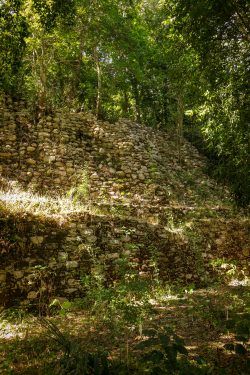
A few weeks ago, on an anniversary trip to Mexico, I dragged1 my wife around the ruins of several ancient Mayan cities. The highlights of these are massive temples, pyramids with steep steps rising high into the air, reminding one of the pyramids of Egypt. The story of the Mayan civilization is fascinating. It is unlike anything you find in North America, with civilizations lasting many centuries advanced enough to create impressive works of art and culture. They even had their own hieroglyphics, one of the only written languages in the New World.
But the Mayans are a mysterious people. By the time the Spanish arrived in the 1500s, in some ways their culture had imploded. Vast cities of many thousands, which had been inhabited for centuries, had been gradually abandoned, many without signs of warfare or a capture and sack. Something mysterious had happened, and they were left to crumble into ruins.

Walking through the rubble and reading the signs and guidebooks, it became apparent that despite impressive archeology and scholarship (including decoding the Mayan language), there is so much that is not known. The buildings do not have “proper” names, they are either numbered, named after an obvious archeological feature (like a red hand print) or given a name that tells more about the imagination of the archeologist than how the Mayans used it (The Castle). With the inhabitants gone forever, we are left to speculate what happened in and on these buildings so many years ago.

There is, of course, much more that can be learned about the Mayans. There is a tremendous amount of archeology that can still be done. Anywhere people live, they leave a lot of things behind them. I’m no archeologist, but I would imagine that many lifetimes could be spent digging up the cities, finding tremendously interesting things. But you don’t need to look even that hard. Entire temples, cities even, are covered in jungle, waiting to be discovered.
Strolling past crumbling walls, I was reminded of the law in the Old Testament that sacrifices could only be offered at the tabernacle, and later the altar in Jerusalem. An entire nation had only one altar for burnt offerings. The Mayans were the opposite of that. Although, as I said, we don’t always know what buildings were used for, many of their great buildings could have been nothing but temples. Those were the buildings at the center of their great cities – not a temple on every corner, but temples taking up every block. It was a culture that seemed to be dedicated to unrestrained sacrifice to their idols. The Old Testament law recognized sacrifices as necessary, but put a severe limit upon them such that their culture could never have the obsession over them that the Mayans did. (Or the Canaanites around them for that matter.)

The Mayan’s obsession with sacrifice, of course, went beyond the killing of animals, to the killing of their fellow man. There is a temple platform in Chichen Itza where the whole base is entirely covered with carved human skulls. It’s a truly chilling sight. The Spanish are criticized for their destruction of the cultures of Mesoamerica. When they came in they toppled the idols, burned the Mayans’ books, set up crosses, and proclaimed the Indians “Christian.” While I’m no fan of the Spanish and their policies in the Americas, I do not think they get enough credit for the good that they did. What was going on in those temples was an abomination. It was morally good that the travesty of human sacrifice was ended. While it is regrettable that scientific and historic texts, for example, were lost forever, we should not find ourselves mourning over burned paper while forgetting the fact that countless people were saved from a cruel death.
Now it must be said that the actions of the Spanish were sullied by the ultimate fate of many of the inhabitants of America who died in the bondage of slavery to new European masters. This is a sad story with no heroes and many villains. But despite what the popular interpretation today might say, the end of the abomination of the Mayans’ human sacrifices, in isolation, was in fact a very good thing.
1. Not technically true






What “Noble savages” they were. (BIG irony)